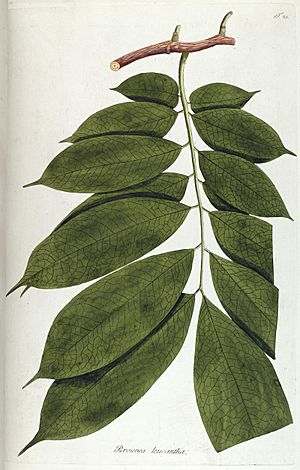Brownea leucantha facts for kids
Quick facts for kids Brownea leucantha |
|
|---|---|
 |
|
| Botanical illustration of Brownea leucantha | |
| Scientific classification | |
| Genus: |
Brownea
|
| Species: |
leucantha
|
| Synonyms | |
|
Hermesias leucantha Kuntze |
|
Brownea leucantha, also known as roso blanco, is a beautiful flowering plant. It belongs to the Brownea genus. This plant is originally from Peru and Venezuela. It is very special because it is the official state tree of Miranda in Venezuela. You can easily tell it apart from other plants in its family because of its unique white flowers.
Contents
What is the Roso Blanco Tree?
The roso blanco is a type of tree that produces stunning flowers. Its scientific name, Brownea leucantha, helps scientists identify it worldwide. The name "leucantha" actually means "white-flowered" in Greek. This perfectly describes its most noticeable feature. These trees are often found in tropical areas. They thrive in warm and humid climates.
What Does the Roso Blanco Look Like?
The roso blanco tree is known for its attractive appearance. It has glossy green leaves. The most striking part of the tree is its flowers. These flowers are usually a pure white color. They grow in dense clusters. These clusters often hang down from the branches. The flowers can be quite large and showy. They make the tree stand out in any landscape. After the flowers, the tree produces seed pods. These pods contain the seeds for new plants.
Where Does the Roso Blanco Grow?
This lovely tree is native to South America. It grows naturally in countries like Peru and Venezuela. It prefers areas with plenty of rainfall. You can often find it in tropical forests. It also grows well in gardens and parks. People plant it for its beauty. It needs warm temperatures to grow properly. It cannot survive in cold or freezing weather.
Its Natural Habitat
In its natural home, the roso blanco tree contributes to the ecosystem. It provides shade for smaller plants. Its flowers attract various pollinators. These include insects and sometimes birds. This helps other plants in the forest to grow. The tree is an important part of the local plant life.
Why is the Roso Blanco Important?
The roso blanco holds special meaning in Venezuela. It is the official state tree for Miranda state. This means it is a symbol of the region. State trees are chosen for many reasons. They might be very common in the area. They could also have cultural importance. Or they might simply be very beautiful. The roso blanco fits these descriptions well.
Cultural Significance
Being a state tree gives the roso blanco a special place. It represents the natural heritage of Miranda. It reminds people of the beauty of their land. Such symbols help to promote local pride. They also encourage people to protect their natural environment. The tree might be featured in local art or stories. It becomes a part of the region's identity.
Uses of the Tree
Beyond its symbolic value, the roso blanco is often planted for ornamental purposes. Its beautiful flowers make it a popular choice. You can see it in botanical gardens. It is also planted in public parks. Some people choose to grow it in their private gardens. It adds a touch of tropical beauty. The tree provides shade, which is valuable in hot climates.
Caring for a Roso Blanco Tree
If you wanted to grow a roso blanco tree, you would need to provide specific conditions. It needs a warm climate. It also requires plenty of water. The soil should be well-drained. This means water should not sit around the roots. It prefers sunny locations. Young trees might need some protection. This helps them grow strong.
Growing Conditions
The roso blanco thrives in tropical or subtropical zones. It needs consistent moisture. However, it does not like waterlogged soil. Good drainage is key for its health. It can grow quite tall over time. Regular care helps it produce many flowers. This makes it a rewarding tree to cultivate.

